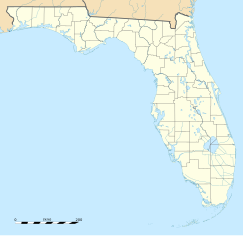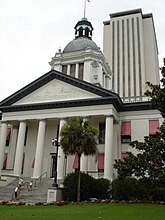Florida State Capitol
| Florida State Capitol | ||
|---|---|---|
| National Register of Historic Places | ||
|
The new State Capitol with the old State Capitol in the foreground |
||
|
|
||
| location | Tallahassee , Leon County , Florida , | |
| Coordinates | 30 ° 26 '17.2 " N , 84 ° 16' 53.6" W | |
| Built | 1845 | |
| NRHP number | 73000584 | |
| The NRHP added | May 7th 1973 | |
The Florida State Capitol in Tallahassee ( Florida , USA ) is the state capitol of the state of Florida. The architecturally and historically significant building has been added to the National Register of Historic Places .
The Capitol is home to offices of government and legislature and the houses of Florida legislature, the Senate, and the House of Representatives . The Capitol is located at the intersection of Apalachee Parkway and Monroe Street in downtown Tallahassee, the capital of Florida.
The Capitol is open to the public Monday through Friday from 8:00 a.m. to 5:00 p.m. (excluding Florida public holidays).
history
Tallahassee was built as the capital of Florida in 1824. The two largest cities in the territory at the time, St. Augustine and Pensacola , had applied for capital. Since one could not agree on either one, a new city was founded between the two cities. The first territorial government resided in log cabins. Construction of a capitol began in 1826, but was never completed. It was completely demolished in 1839 to make room for the current building. This was completed in 1845 just before Florida became the 27th state to join the United States. Various additions have been made since then. Frank Millburn made the first expansion by adding the classically shaped dome. In 1923, Henry Klutho added two new wings and the marble interior. Finally, in 1936 and 1947, a large wing was added for the House of Representatives and the Senate.
On May 7, 1973, the Florida State Capitol was added to the National Register of Historic Places . When the new Capitol was built in the late 1970s, the historic Capitol was threatened with demolition. A citizens' initiative led by Secretary of State Bruce Smathers and later Nancy McDowell successfully campaigned for the preservation. The building was rebuilt to the state of 1902. The architectural features include the elaborately designed glass dome, the red and white striped awnings and a representation of the seal of the state of Florida over the pillars at the entrance.
Architecture and design
The design for the Capitol complex was a joint venture between the architects Edward Durell Stone from New York City and Reynolds, Smith and Hills from Jacksonville .
The Capitol is 105 m high, has 22 floors and three underground floors. The 6th floor can only be reached with a freight elevator. The governor and cabinet members have their offices on the ground floor. Occupy the next three floors:
- the boardrooms of the Senate and House of Representatives
- the Senate: President, Secretary and Sergeant at Arms
- the House of Representatives: Spokesman, Secretary and Sergeant at Arms
- some legislative committees and meeting rooms and offices of deputies.
The legislative chambers are on the fourth floor, and their stands are on the fifth floor. There are executive and legislative offices between the viewing platform and the fifth floor. There is a cafeteria in the basement, a snack bar on the 10th floor and the Florida Welcome Center is located directly at the western entrance from the plaza. The Senate and House of Representatives office buildings have 4 floors and are located at opposite ends of the Capitol complex. The 2nd and 3rd floors of the office buildings are connected to the Capitol by bridges. In these buildings there are mainly conference rooms and administration offices. The Knott Building was connected to the Capitol with a skyway in 1999 . The Western Front is formally known as Waller Park, named after Curtis L. Waller, a judge on the United States Court of Appeals . In 2003, the Stormsong dolphin statue was installed with Waller Park's Florida Heritage Fountain.
statistics
During the construction of the Capitol, the following were used:
- 3,700 tons of structural steel
- 2,800 t of reinforcing steel
- 19,000 m³ of concrete
- 1,100 m² walnut paneling
- 45,000 liters of paint
- 5,800 m² of Italian marble
- 6,000 m² of carpet
- 8,500 m² terrazzo floors
- 48 km of telephone cables
- 400 km of power cables
3.2 million working hours were performed during the construction period of 1016 days. The entire area has an area of 66,700 m², enough land for 400 houses. The Capitol has 66 public toilets, 40 stairs, 14 elevators, an underground car park with 360 parking spaces and over 2000 doors. The cost of construction was $ 43,070,741. An additional $ 1,957,338 was spent on landscaping, the plaza, fountains, and the stairs on the west side. The grand total was $ 45,028,079.
About 1500 people work in the Capitol for a large part of the year. However, when the legislation is in session, there will be close to 5000 people in the building. The architects and engineers who designed and built the Capitol estimate its lifespan to be 100 years.
Interesting places
Capitol complex
On the northeast corner of the is the Florida Sri Chinmoy Peace State marker. To the east of the House of Representatives office building is a copy of the Liberty Bell . The copy was a gift from the United States to the citizens of Florida as a reminder of the sale of Federal Treasury Bills in 1950. In the Capitol's courtyard is a memorial to Martin Luther King , dedicated in 1984. South of the King Memorial is the Law Enforcement Memorial the Fraternal Order of Police (dedicated 2000). The memorial shows the names of police officers who were killed on duty. Outside the Senate office building is a memorial to the Florida Purple Heart bearers . Two marble obelisks stand on the lawn of the Old Capitol. The northern obelisk is dedicated to the Leon County men who died in the Civil War. The other oblisk is a memorial to Capt. John Parkhill, who was killed in Palm Hammock, Florida while leading the Leon volunteers hunting down Seminole Indians. Just northwest of the Civil War Obelisk is the Old Capitol Historical Marker. On the south wall of the Westpark entrance is a plaque commemorating the law that named this area after Judge Curtis L. Waller. The Florida Heritage Fountain and Stormsong are in the middle of Waller Park.
Capitol
The Plaza Level offers other points of interest in addition to the governor's offices and the cabinet. In the rotunda there is a bronze copy of the Florida state seal that was in effect at the time the building was completed. It is encircled by smaller seals that represent the major sovereign nations that controlled Florida: ( France , Spain , Great Britain , the Confederate States of America, and the United States ). North of the rotunda are Florida's Hall of Fame for women and the wall of honor for deceased firefighters. To the south are the Hall of Fame for Florida Artists and a memorial to recipients of the Florida Congressional Medal of Honor. To the southwest is the Heritage Chapel, a meditation area. Opposite the chapel is a plaque that reads “This plaque is dedicated to Senator Lee Wisenborn, whose valiant efforts to bring the Capitol to Orlando were the main motivation for building this building”. In the western part of the Plaza Level you will find the Florida Welcome Center and the murals "Images of the Sunshine State" by James Rosenquist. The Florida Welcome Center offers maps, brochures, and related information.
The stands for the House of Representatives and the Senate are on the 5th floor. A series of murals depicting Florida history by Christopher Still frame the floor of the House of Representatives. In front of the Senate tribune is the Five Flags mural by Renee Faure, depicting the five flags and people from Florida history.
The closed viewing platform is located on the 22nd floor of the Capitol. It is 94 m above the plaza and 156 m above sea level and is divided into east and west sides. In the eastern part there is an art gallery with changing exhibitions of artists from Florida. The western part can be rented for events. On the south wall is the "Freedom Shrine", a collection of copies of historical documents, e. B. the United States Constitution.
Florida Legislative Research Center & Museum
The Capitol is home to the Florida Legislative Research Center & Museum , which displays exhibits about the history of Florida's legislation. The archives include works of art, historical photographs and oral histories . The gallery in the historic Capitol shows changing exhibitions of photographs from the museum.
See also
Web links
- Florida Historic Capitol Museum (English)
- The story of the Florida Capitol - Florida Department of State
- The Old Capitol (The Florida Center of Political History and Governance)
- Florida Department of Management Services ( July 5, 2008 memento on the Internet Archive )
- Florida Legislative Research Center & Museum - Official Site
- Virtual tour of the Capitol
Individual evidence
- ↑ Florida State Capitol on the National Register Information System. National Park Service , accessed August 7, 2017.
- ^ Sri Chinmoy Peace State Marker - Tallahasseer . 2013. Retrieved November 28, 2013.




